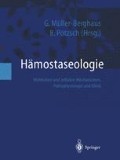Zusammenfassung
Die beiden Internisten Conley und Hartmann beschrieben im Jahr 1952 erstmals bei einem Patienten mit systemischem Lupus erythematodes eine Verlängerung der aktivierten partiellen Thromboplastinzeit (APTT) und verlängerte Gerinnungszeiten in der Einzelfaktorenanalyse, die durch Mischen mit Normalplasma nicht adäquat korrigiert werden konnten. Aufgrund der Koinzidenz des Lupus erythematodes und dem Auftreten dieser antikoagulatorischen Aktivität im Plasma betroffener Patienten wurde der Begriff des Lupus antikoagulans (LA) geprägt. Die ursprünglich bei Patienten mit einem LA vermutete erworbene Blutungsneigung konnte in der Folge nicht bestätigt werden. Betroffene Patienten zeigten im Gegenteil ein gehäuftes Auftreten von thromboembolischen Komplikationen. Systematische Untersuchungen größerer Patientenpopulationen belegten diese klinische Beobachtung, so daß das LA als ein erworbener thrombophiler Risikofaktor charakterisiert werden kann. Außerdem konnte gezeigt werden, daß die Manifestation eines LA nicht auf Patienten mit einem Lupus erythematodes beschränkt ist, sondern auch bei Patienten ohne eine andere nachweisbare Grunderkrankung auftreten kann. Untersuchungen von verschiedenen Arbeitsgruppen zeigten, daß die der In-vitro-Manifestation des LA zugrundeliegende antikoagulatorische Aktivität einem Antikörper zugeordnet werden kann. Ausgehend von der Beobachtung, daß durch Zugabe von phos-pholipidreichen Fraktionen wie z.B. lysierten Thrombozytenmembranen oder durch die Zugabe von gereinigten Phospholipiden die initial verlängerten Gerinnungszeiten verkürzt werden können, wurden Phospholipide als die antigene Komponente identifiziert. Weiterführende Untersuchungen zeigten jedoch, daß nicht Phospholipide alleine, sondern Komplexe, bestehend aus phospholipidbindenden Proteinen und Phospholipiden, das zur LA-Antikörperbildung führende: Antigen darstellen. Das β 2-Glykoprotein I und das Prothrombin stellen die beiden wichtigsten Proteinkomponenten dar. Mit der Kompetition der LA-Antikörper mit den Vitamin-K-abhängigen Gerinnungsfaktoren um die im In-vitro-Ansatz nur begrenzt vorhandenen Phospholipide wird die Verlängerung der gemessenen Gerinnungszeiten in phospholipidabhängigen Gerinnungstesten erklärt. Demgegenüber ist der pa-thophysiologische Mechanismus, durch den LA-Antikörper das Entstehen von thromboembolischen Komplikationen begünstigen, trotz verschiedener Erklärungsmodelle bisher nicht eindeutig identifiziert.
Access this chapter
Tax calculation will be finalised at checkout
Purchases are for personal use only
Preview
Unable to display preview. Download preview PDF.
Literatur
Bevers EM, Galli M, Barbui T et al. (1991) Lupus anticoagulant IgGs (LA) are not directed to phospholipids only, but to a complex of lipid-bound human prothrombin. Thromb Haemost 66:629–632
Conley CL, Hartmann RC (1952) A hemorrhagic disorder caused by circulating anticoagulant in patients with disseminated lupus erythematosis. J Clin Invest 31:621–622
Esmon NL, Smirnov MD, Esmon CT (1997) Thrombogenic mechanisms of antiphospholipid antibodies. Thromb Haemost 78:79–82
Exner T, Triple« DA, Taberner D, Machin SJ (1991) Guidelines for testing and revised criteria for lupus anticoagulants. Thromb Haemost 65:320–325
Galli M, Finazzi G, Barbui T (1997) Antiphospholipid antibodies: Predictive value of laboratory tests. Thromb Haemost 78:75–78
Khamashta MA, Cuadrado MJ, Mujic F et al. (1995) The management of thrombosis in the antiphospholipid-anti-body syndrome. N Engl J Med 332:993–997
Lechner K, Eichinger S, Jäger U et al. (1992) Lupus anticoagulant and clinical correlates. In: Neri Serneri GG, Gensi-ni GF, Abbate R, Prisco D (eds) Thrombosis. An update. Scientific, Florence, pp 47–60
McNeil HP, Simpson RJ, Chesterman CN, Krilis SA (1990) Antiphospholipid antibodies are directed against a complex antigen that includes a lipid-binding inhibitor of coagulation: β 2-glycoprotein I (apolipoprotein H). Proc Natl Acad Sci USA 87:4120–4124
Moll S, Ortel TL (1997) Monitoring warfarin therapy in patients with lupus anticoagulants. Ann Intern Med 127:177–185
Rosove MH, Brewer PMC (1992) Antiphospholipid thrombosis clinical course after the first thrombotic event in 70 patients. Ann Intern Med 117:303–308
Roubey RAS (1994) Autoantibodies to phospholipid-binding plasma proteins: A new view of lupus anticoagulants and other “antiphospholipid” autoantibodies. Blood 84:2854–2867
Schulz DR (1997) Antiphospholipid antibodies: basic immunology and assays. Semin Arthritis Rheum 26:724–739
Sebastiani GD, Galeazzi M, Morozzi G, Marcolongo R (1996) The immunogenetics of the antiphospholipid syndrome anticardiolipin antibodies, and lupus anticoagulant. Semin Arthritis Rheum 25:414–420
Triplett DA, Brandt JT, Musgrave KA, Orr CA (1988) The relationship between lupus anticoagulants and antibodies to phospholipid. JAMA 259:550–554
Wahl DG, Guillemin F, Demaistre E et al. (1998) Meta-analysis of the risk of venous thrombosis in individuals with antiphospholipid antibodies without underlying autoimmune disease or previous thrombosis. Lupus 7:15–22
Editor information
Editors and Affiliations
Rights and permissions
Copyright information
© 1999 Springer-Verlag Berlin Heidelberg
About this chapter
Cite this chapter
Lechner, K., Pötzsch, B. (1999). Lupus antikoagulans. In: Müller-Berghaus, G., Pötzsch, B. (eds) Hämostaseologie. Springer, Berlin, Heidelberg. https://doi.org/10.1007/978-3-662-07673-6_45
Download citation
DOI: https://doi.org/10.1007/978-3-662-07673-6_45
Publisher Name: Springer, Berlin, Heidelberg
Print ISBN: 978-3-662-07674-3
Online ISBN: 978-3-662-07673-6
eBook Packages: Springer Book Archive

